
A defensive wall is a fortification usually used to protect a city, town or other settlement from potential aggressors. The walls can range from simple palisades or earthworks to extensive military fortifications with towers, bastions and gates for access to the city. From ancient to modern times, they were used to enclose settlements. Generally, these are referred to as city walls or town walls, although there were also walls, such as the Great Wall of China, Walls of Benin, Hadrian's Wall, Anastasian Wall, and the Atlantic Wall, which extended far beyond the borders of a city and were used to enclose regions or mark territorial boundaries. In mountainous terrain, defensive walls such as letzis were used in combination with castles to seal valleys from potential attack. Beyond their defensive utility, many walls also had important symbolic functions – representing the status and independence of the communities they embraced.

Ajdovščina is a town in the Vipava Valley, Slovenia. It is the administrative seat of the Municipality of Ajdovščina.

A fortification is a military construction or building designed for the defence of territories in warfare, and is also used to establish rule in a region during peacetime. The term is derived from Latin fortis ("strong") and facere.

Eboracum was a fort and later a city in the Roman province of Britannia. In its prime it was the largest town in northern Britain and a provincial capital. The site remained occupied after the decline of the Western Roman Empire and ultimately evolved into the present-day city York, occupying the same site in North Yorkshire, England.

Novae was initially one of the few great Roman legionary fortresses along the empire's border, forming part of the defences along the Danube in northern Bulgaria. The settlement later expanded into a town in the Roman province of Moesia Inferior, later Moesia Secunda.

Ir Ovot is a small village in southern Israel. Located in the northeastern Arabah, it falls under the jurisdiction of Central Arava Regional Council. It operated as a kibbutz from 1967 until the 1980s. In 2019 it had a population of 54.

Oescus, Palatiolon or Palatiolum was an important ancient city on the Danube river in Roman Moesia. It later became known as Ulpia Oescus. It lay northwest of the modern Bulgarian city of Pleven, near the village of Gigen.

Located in Turkey, the settlement of Satala, according to the ancient geographers, was situated in a valley surrounded by mountains, a little north of the Euphrates, where the road from Trapezus to Samosata crossed the boundary of the Roman Empire, when it was a bishopric, which remains a Latin Catholic titular see. Later it was connected with Nicopolis by two highways. Satala is now Sadak, a village of 500 inhabitants, in the Kelkit district of Gümüşhane Province in Turkey.
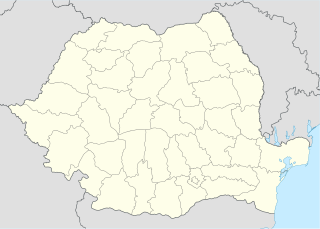
Dinogetia was an ancient Geto-Dacian settlement and later Roman fortress located on the right (southern) bank of the Danube near the place where it joins the Siret. The Dinogetia site is situated in Northern Dobruja 8 kilometres east of Galați, Romania and 2 kilometers north of Gărvan, a village in Jijila commune.

The Vipava Valley is a valley in the Slovenian Littoral, roughly between the village of Podnanos to the east and the border with Italy to the west. The main towns are Ajdovščina and Vipava.

Brežice Castle is a 16th-century castle in the town of Brežice, in southeastern Slovenia, at the street address Cesta prvih borcev 1.

Bohinjska Bistrica is the largest settlement and administrative centre of the Municipality of Bohinj, in the Upper Carniola region of northwestern Slovenia.

Povir is a village in the Municipality of Sežana in the Littoral region of Slovenia. It includes the hamlets of Britof, Dulanja Vas, and Guranja Vas.

Lokavec is a settlement on the northern edge of the Vipava Valley northwest of Ajdovščina in the Littoral region of Slovenia. It lies below the slopes of Mount Čaven, below the Slano Blato Landslide. It includes the hamlets of Bitovi, Brith, Čohi, Gorenje, Kuši, Lahovše, Loretovše, Mizinška Vas, Paljki, and Slokarji.

Otlica is a dispersed settlement in the hills north of Ajdovščina in the Littoral region of Slovenia. It is made up of smaller clusters of the hamlets of Sibirija, Kitajska, Kurja Vas, and Cerkovna, as well as a number of outlying isolated farms. Together with the ridge-top villages of Predmeja, Kovk, and Gozd, it is part of an area locally known as Gora.
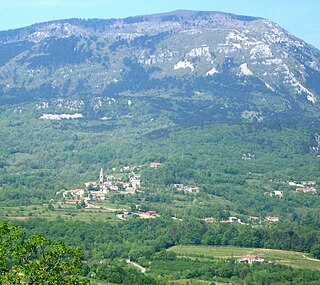
Stomaž is a village in the hills north of the Vipava Valley in the Municipality of Ajdovščina in the Littoral region of Slovenia. It is made up of several smaller hamlets: Brith, Dolenja Vas, Hrib, Ljubljanica, Griže, Črnigoji, Bratini, and Batagelji.
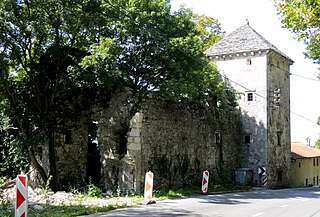
Trilek Castle, also known as Old Castle, is a small castle or fort in the settlement of Col, in the Municipality of Ajdovščina in southwest Slovenia. Built in the early 16th century, it was first mentioned in the 17th-century historian Johann Weikhard von Valvasor's 1689 survey The Glory of the Duchy of Carniola.

Claustra Alpium Iuliarum was a defense system within the Roman Empire between Italia and Pannonia that protected Italy from possible invasions from the East. It secured the Postojna Gate, the land link between the eastern and western part of the empire, and thus the Claustra represented an inner border defense of the empire. Unlike a linear rampart, the Claustra consisted of a series of interconnected fortifications with its center at Castra ad Fluvium Frigidum ; other important fortresses were Ad Pirum on today's Hrušica Plateau and Tarsatica, now a part of the city of Rijeka. They had been governed from the town of Aquileia.
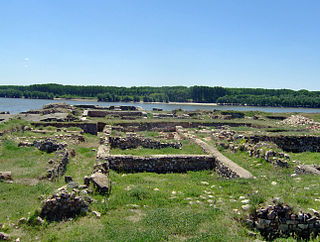
Capidava was an important Geto-Dacian center on the right bank of the Danube. After the Roman conquest, it became a civil and military center, as part of the province of Moesia Inferior, modern Dobruja.
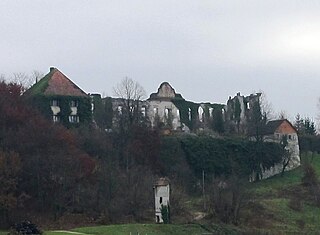
Boštanj is a formerly independent settlement in the southern part of the village of Veliko Mlačevo in central Slovenia. It belongs to the Municipality of Grosuplje. It is part of the traditional region of Lower Carniola and is now included with the rest of the municipality in the Central Slovenia Statistical Region.





















